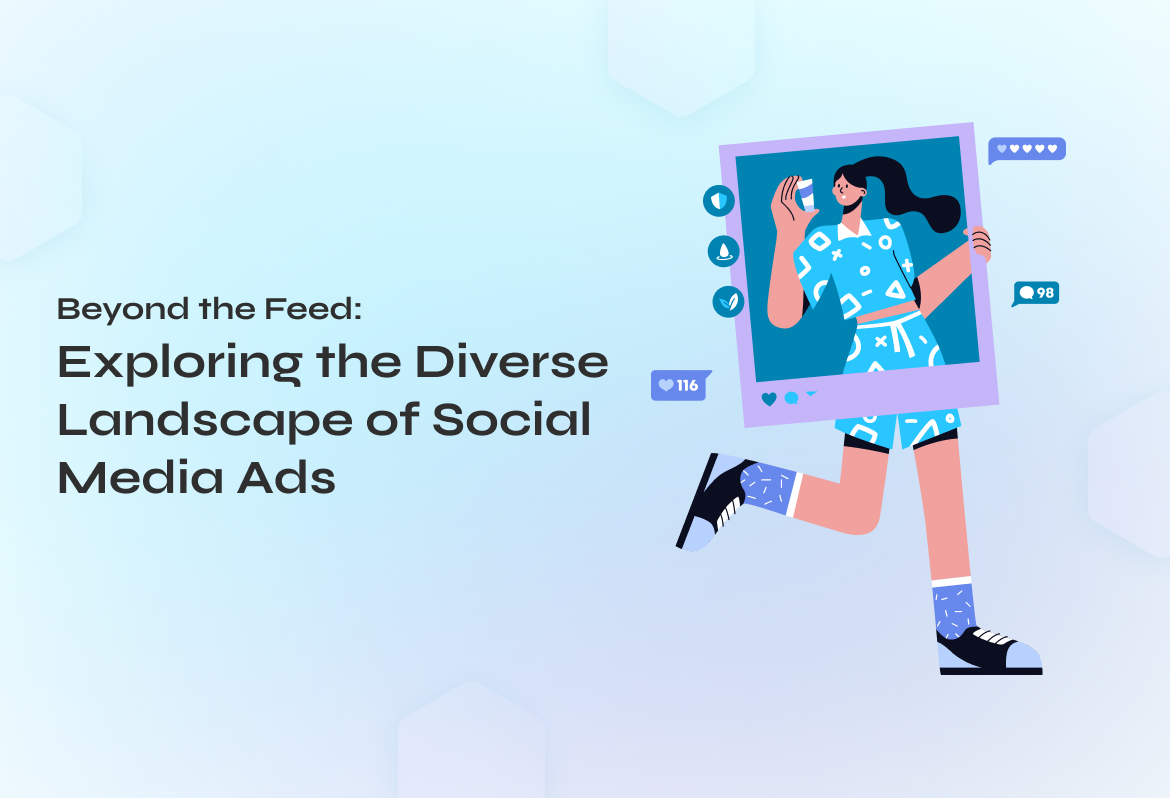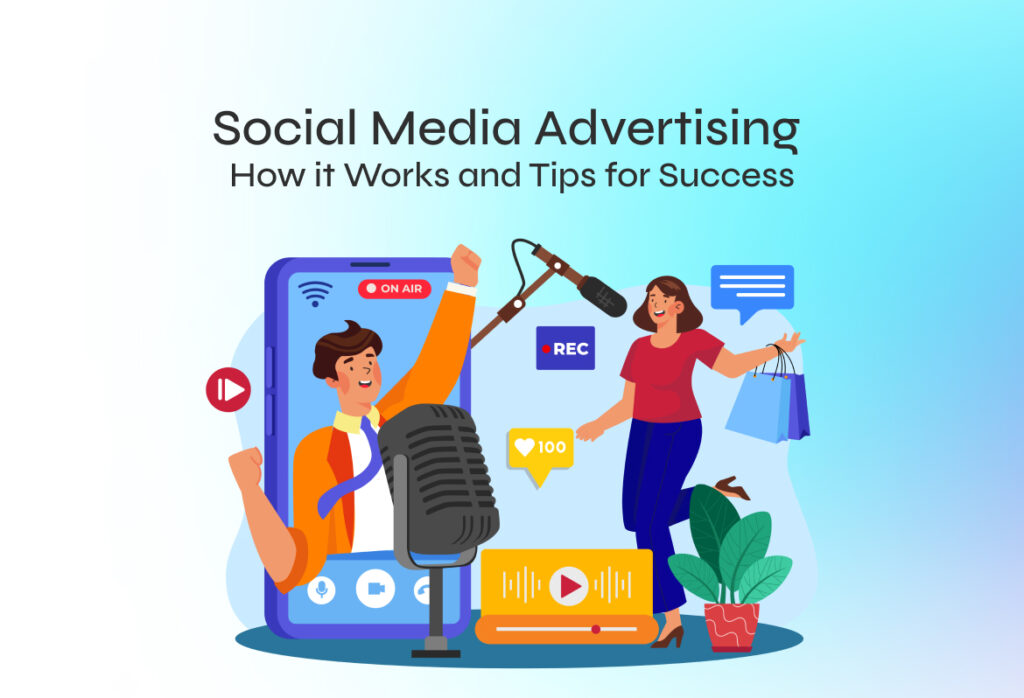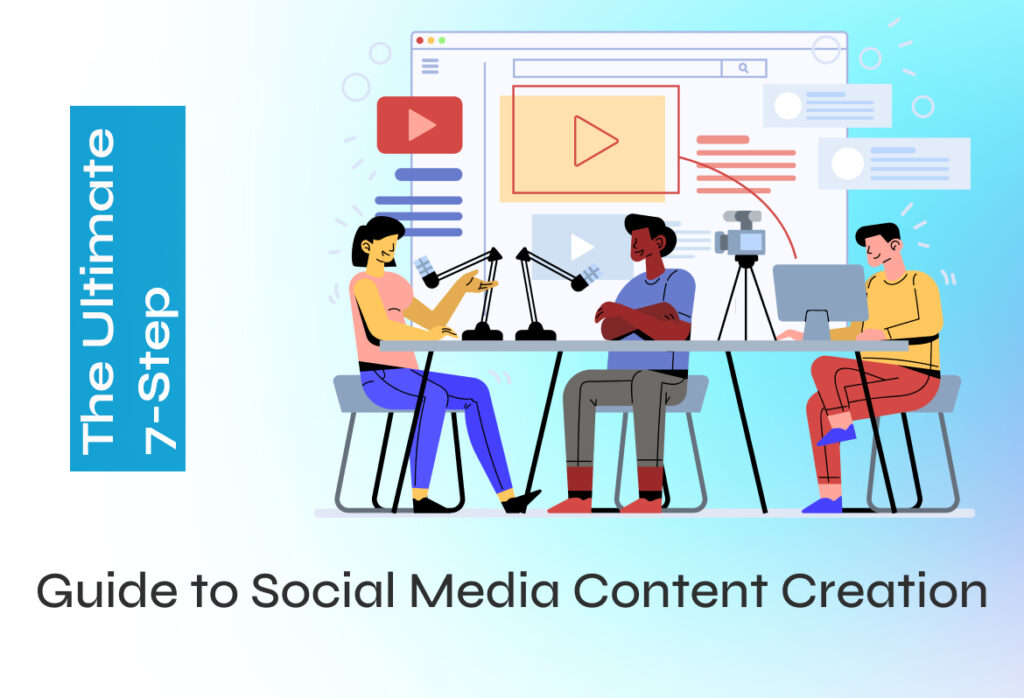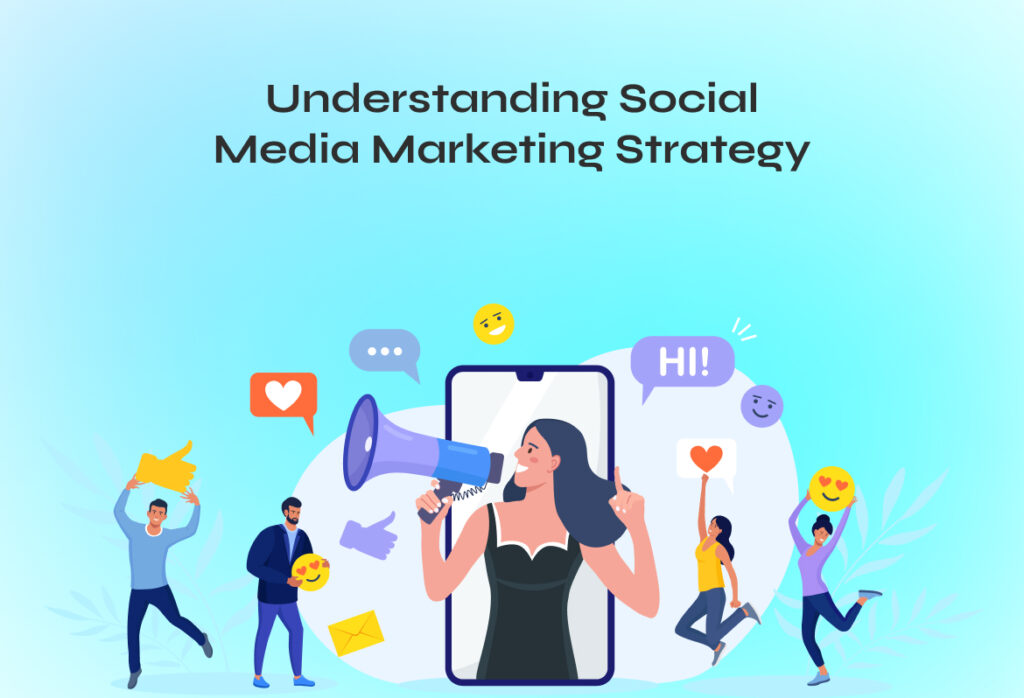In the era where technology has taken the world by storm, social media has also evolved into much more than a platform for personal updates and entertaining videos. It’s become a dynamic marketplace where businesses interact with potential customers. This bustling online environment is rich with targeted advertising, specifically designed to catch the eye of the right viewer.
As we delve into this article, we’ll explore the world of social media ads. From their definition to the different types and the strategies behind them, we’ll find out how these digital ‘billboards’ are shaping the way businesses connect with their audience in the wide world of social media.
What Are Social Media Ads?
Social media ads are like custom-made billboards in your digital world. Imagine you’re scrolling through Facebook, Instagram, Twitter, or any other social media platform. Sometimes, you come across posts that are different from regular ones. They could be about a food spot in your area, a big sale at a brand you love, or a service offered by a company. These standout posts are actually ads, but they’re not just any ads. They’re designed to grab your attention because they’re based on what you can relate to or talk about.
If you love movies and you post about them or interact with similar content. Soon, you’ll notice ads popping up about the latest movie releases, streaming services, or nearby movie theaters. This isn’t just luck. Social media platforms are really smart. They use the information from your posts and interactions to figure out what kinds of ads you might find interesting.
Additionally, these social media ads have been quite beneficial for businesses and there is a good reason for that. These platforms are used by over 4.9 billion people globally. That’s a massive number of potential customers who can help make businesses or brands famous. With so many people using these platforms, businesses have an incredible opportunity to reach a wide audience. They can show their ads to the people who are most likely to be interested in what they’re selling. This smart targeting is what makes social media ads so effective and popular among businesses of all sizes.
Why Are They Everywhere?
You’re seeing these ads because businesses want to chat with people who might like what they’re selling. And the best part? They don’t want to bother everyone, just those who might genuinely be interested. So, instead of seeing random ads that have nothing to do with you, you get ads that are more like personal recommendations.
Social media ads are those special, targeted posts or videos you see on social media platforms. They’re paid for by businesses, and they’re designed to reach people who are most likely to be interested in what’s being advertised. It’s a smart way for businesses to talk directly to potential customers and for you to discover products and services that actually align with your interests.
So next time you’re scrolling through your social feed and see an ad, remember, it’s not just a random post. It’s a carefully crafted message, designed with someone like you in mind!
Different Types of Social Media Ads
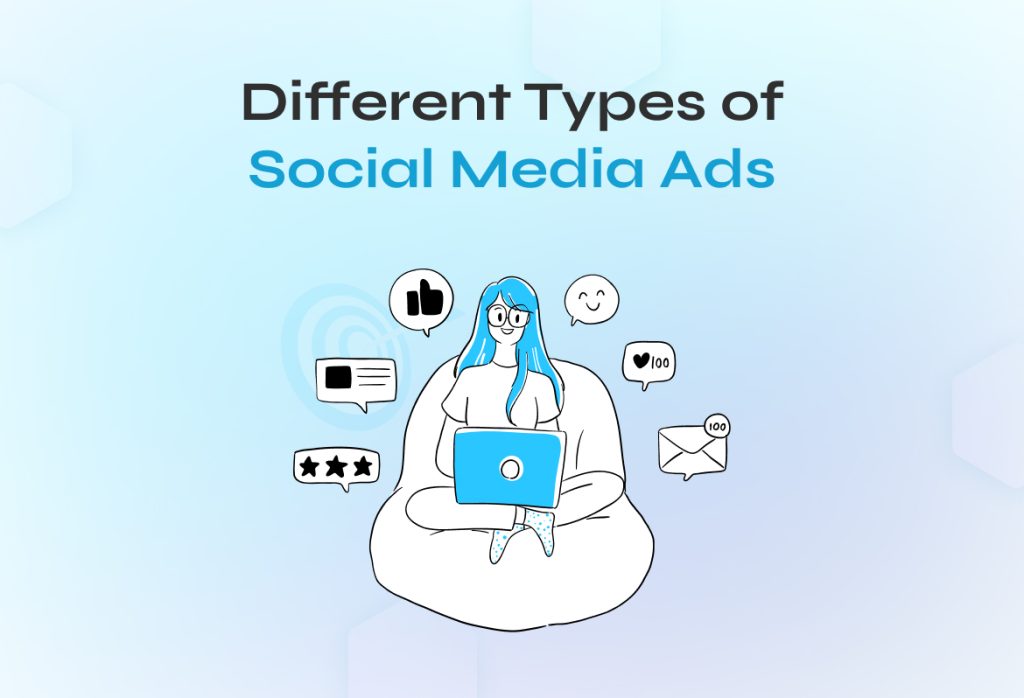
- Image Ads: These are simple yet powerful. An image ad is just a picture with some text. It’s like seeing a photo in a magazine, but on your social media feed. These ads can show off a product, a special offer, or just something fun to grab your attention. These ads also have a call to action (CTA) most of the time.
- Video Ads: These are moving pictures or short films. You might see them start playing as you scroll. They’re great because they can tell a story, show a product in action, or just make you laugh. Video ads can be anything from a few seconds to a couple of minutes long.
- Carousel Ads: Imagine flipping through a photo album. That’s what a carousel ad is like. It has multiple images or videos in one ad. You can swipe through them to see different products or different parts of a story. Each photo or video can have its own link too, so if you see something you like, you can click right on it.
- Stories Ads: These are the ads that appear when you’re watching stories on platforms like Instagram or Snapchat. They’re full-screen and usually last only a few seconds. Stories ads are great for sharing quick, engaging messages or offers that are only available for a short time.
- Influencer Ads: These are a bit different. They involve someone popular on social media – an influencer – talking about a product or service. It’s like a friend showing you something they like. These ads can feel more personal and trustworthy because they come from someone you might already follow and admire.
- Sponsored Posts: These look like regular posts, but a business has paid to get them in front of more people. They can be just text, text with an image, or even a video. They usually have a little label that says ‘sponsored’ or ‘promoted’ to let you know it’s an ad.
- Interactive Ads: These ads want you to do something, like vote in a poll, answer a question, or play a mini-game. They’re fun and engaging, and they get people talking about the product or service.
- Lead Generation Ads: These are for when businesses want to get more information from potential customers, like their email addresses. These ads might ask you to sign up for a newsletter, get a discount, or enter a contest. In return, you give them a bit of information about yourself.
Each type of social media ad has its own way of catching your attention and telling you about something you might be interested in. Whether it’s through a stunning image, an engaging video, a fun interactive experience, or a personal recommendation from an influencer, these ads are designed to match the interests and needs of their viewers. By understanding these different types, you can better appreciate the creativity and strategy behind the ads you see in your social media feeds.
Platforms for Social Media Ads
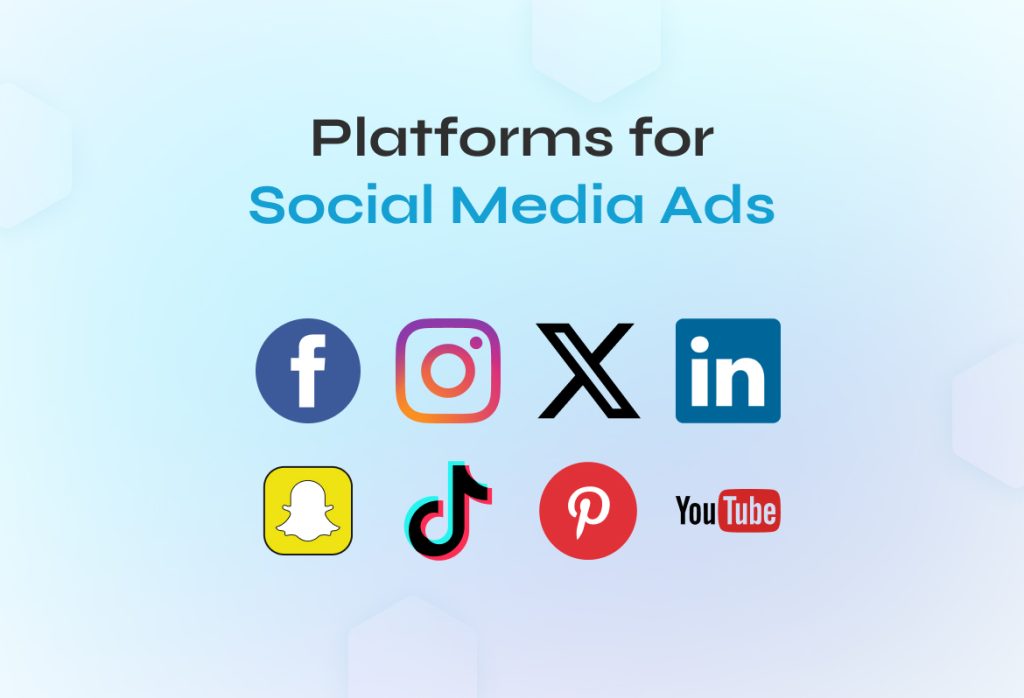
Social media marketing has been booming when it comes to engaging with the audience. Being at the right place at the right time is main key over here.
When choosing where to place your social media ads, it’s crucial to pick the right platform. Each social media site is like a different neighborhood, each with its unique crowd and culture. Let’s take a closer look at some of the most popular platforms.
- Facebook: As the second most popular social media channel just behind WhatsApp, Facebook is a powerhouse for social media ads. It’s a diverse community where a wide range of age groups are present. The beauty of Facebook is its massive reach and sophisticated ad targeting options. It’s like a bustling marketplace where you can find almost everyone, from teenagers to grandparents. With its advanced analytics, Facebook helps advertisers understand and reach their target audience effectively.
- Instagram: With over 1 billion monthly active users, Instagram is a visual paradise. It’s particularly popular among younger demographics who are attracted to its vibrant and creative content. Ads on Instagram have the potential to reach nearly 30% of internet users, making it a goldmine for businesses aiming to engage with a visually oriented audience. Instagram ads are perfect for brands that have a strong visual appeal and can create eye-catching, compelling content.
- Twitter: Known for its real-time updates and concise content, Twitter is ideal for timely, engaging ads that are short and to the point. It’s great for reaching a more mature audience who appreciate news, entertainment, and sports updates.
- LinkedIn: As the go-to platform for professional networking, LinkedIn is ideal for B2B advertisements and for reaching a more professional audience. Ads here can be targeted based on job titles, industries, and professional interests, making it a strategic choice for specific business-oriented products and services.
- Snapchat: Popular among younger audiences, Snapchat offers a playful platform for creative, short-lived content. It’s perfect for brands looking to engage with a younger crowd through fun and innovative visuals.
- TikTok: A rising star in the social media world, TikTok is dominated by Gen Z and younger millennials. It’s all about short, engaging video content, offering a unique opportunity for creative, trend-focused advertising.
- Pinterest: Ideal for businesses in fashion, decor, art, and similar industries, Pinterest is great for targeting an audience interested in visual inspiration and ideas.
- YouTube: As a video-sharing platform, YouTube offers a space for longer-form content and can be a great choice for detailed product demonstrations, tutorials, or storytelling.
In a world where people spend an average of 2 hours and 28 minutes per day on social media, these platforms provide businesses with an unparalleled opportunity to reach their audience where they are most active. The key is to understand the unique environment and audience of each platform and tailor your ads accordingly to achieve the best results. With ad spending on social media projected to reach over $268 billion in 2023, it’s evident that businesses are recognizing and capitalizing on the power of these diverse digital neighborhoods.
Examples of Social Media Ads on different platforms:
There are different types of ads on different platforms. Each platform has a unique way of engaging with the audience. We’ll go through few of the most common and important social media platforms to help you understand what purpose each ad serve.
Ads on Facebook
Let’s start with Facebook first. Facebook is one of the most used social media platform in the world. That means it should be in your social media ad campaigns to target your audience. Here are a couple of Facebook Ad examples:
Static Image Ad:
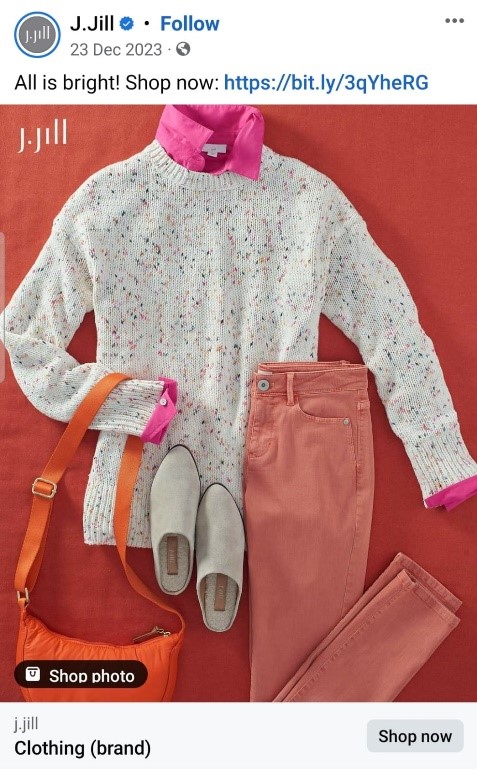
This is an example of Facebook image ad that showcases the clothing brand J.Jill. The ad features a photo array of various clothing items, presented in a way that catches the viewer’s attention. Accompanying this visual display is the caption “All is bright! Shop now,” which not only highlights the vibrant and lively nature of the collection but also serves as an invitation for potential customers to explore their offerings.
Prominently placed in the lower right corner of the ad is a call-to-action (CTA) button labeled “Shop now.” This button, when clicked, conveniently directs users to J. Jill’s website, where they can browse and purchase items from the collection. This seamless integration of visual appeal and easy navigation is designed to engage and encourage viewers to shop from their brand.
Carousal Ads:
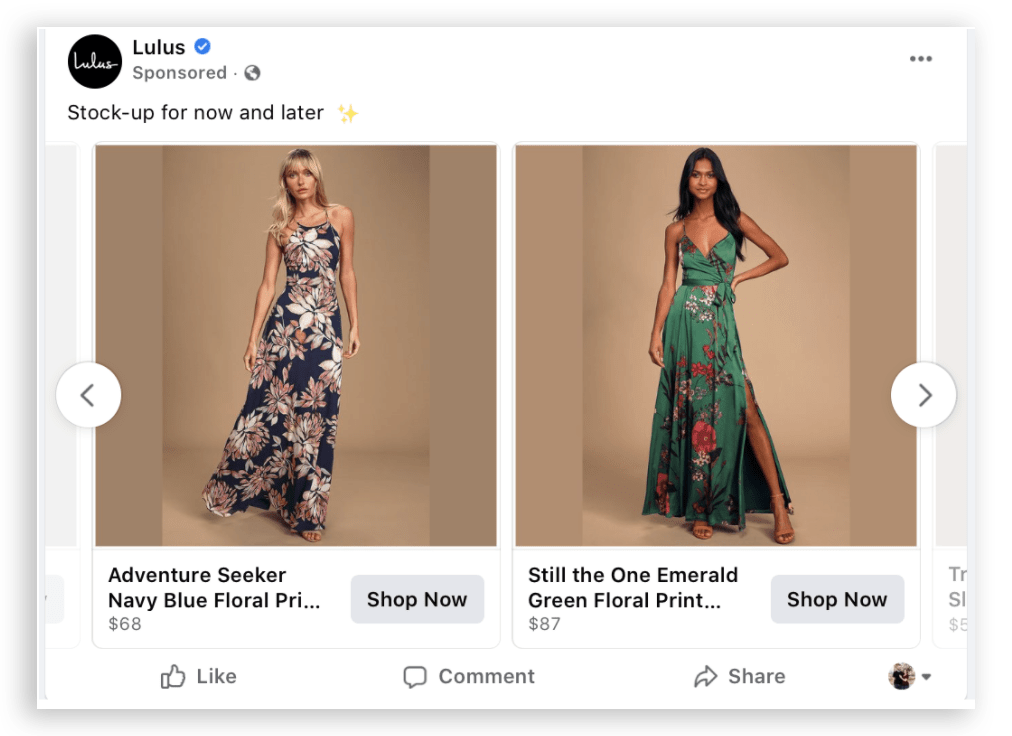
This image is an example of a carousel ad. Unlike a regular static image ad, a carousel ad contains several images that you can swipe through from right to left. This lets you see different products or offerings from a brand in just one ad.
Each image in this carousel ad features its own “Shop now” call-to-action (CTA) button. When you click on this button, you’re taken directly to the brand’s official website. This is really handy for quickly finding more details or making a purchase.
Also, you can add engaging captions to each image in the carousel, just like you can with Facebook video ads and static image ads. These captions can be informative or entertaining, adding an extra layer of engagement to the ad. It’s a dynamic way for brands to showcase a variety of products or different aspects of a single product in an interactive and user-friendly format.
Instagram Ads
Instagram is known for marketing of brands. If you’re thinking about of a social media ad campaign, have a look a at these ads before you start.
Static and Carousal Ads
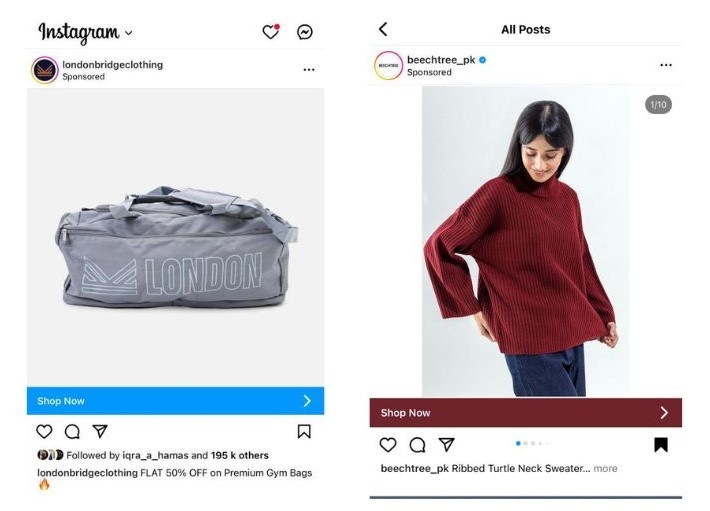
Instagram and Facebook are owned by the same company, so ads on both platforms are pretty similar. When you create an ad, adding captions and a call-to-action (CTA) button, like “Shop Now” or “Learn More,” works the same way on both Instagram and Facebook.
The main difference between ads on these platforms is how they look – the style and design. The pictures show examples of static image ads and carousel ads on Instagram. While the way you add text and buttons is the same as on Facebook, Instagram ads have their own unique look to match the style of Instagram.
This is important because Instagram is all about great photos and cool visuals. So, ads on Instagram are designed to fit in with all the other eye-catching posts people see on their feed. They look a bit different from Facebook ads to make sure they grab your attention in the right way while you’re scrolling through Instagram.
Twitter Ads
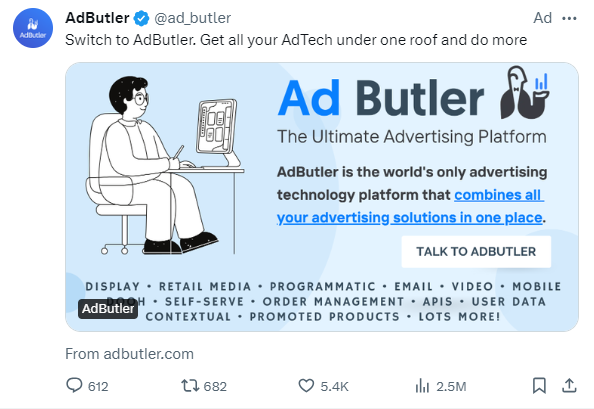
Twitter ads blend into your feed but stand out with a “Promoted” label. They look like regular tweets and include engagement buttons—likes, retweets, comments—for interaction. These ads often have eye-catching images or videos, a snappy headline, and sometimes a call-to-action button that invites you to learn more or buy a product. They’re designed to convey a message quickly and engage you as you scroll. The above given image is a twitter ad by adbutler.
TikTok and Youtube Ads
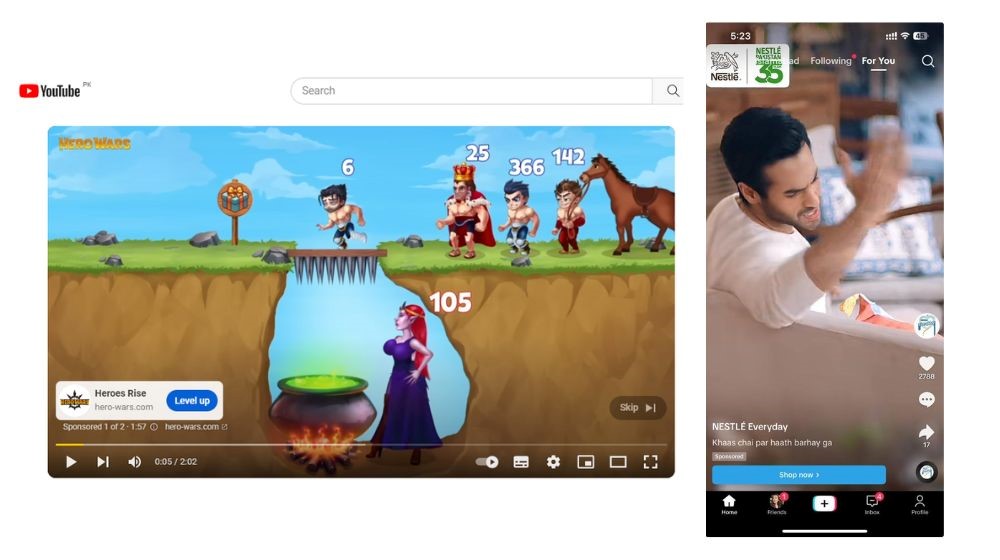
TikTok and YouTube are both places where you watch videos, but they’re a bit different. TikTok has short videos that can be up to 10 minutes long. They’re quick and fun to watch. YouTube has all kinds of videos, some are really short, and some can be as long as a movie.
Most ads on TikTok and YouTube are videos too, and you don’t always have to watch the whole ad. On TikTok, if you see an ad, you can just swipe up to get to the next video. On YouTube, after the ad plays for a bit, you can click a button that says “Skip Ad” to move on to the video you want to watch. It’s a simple way to let you choose if you want to see the ad or not.
LinkedIn Ads
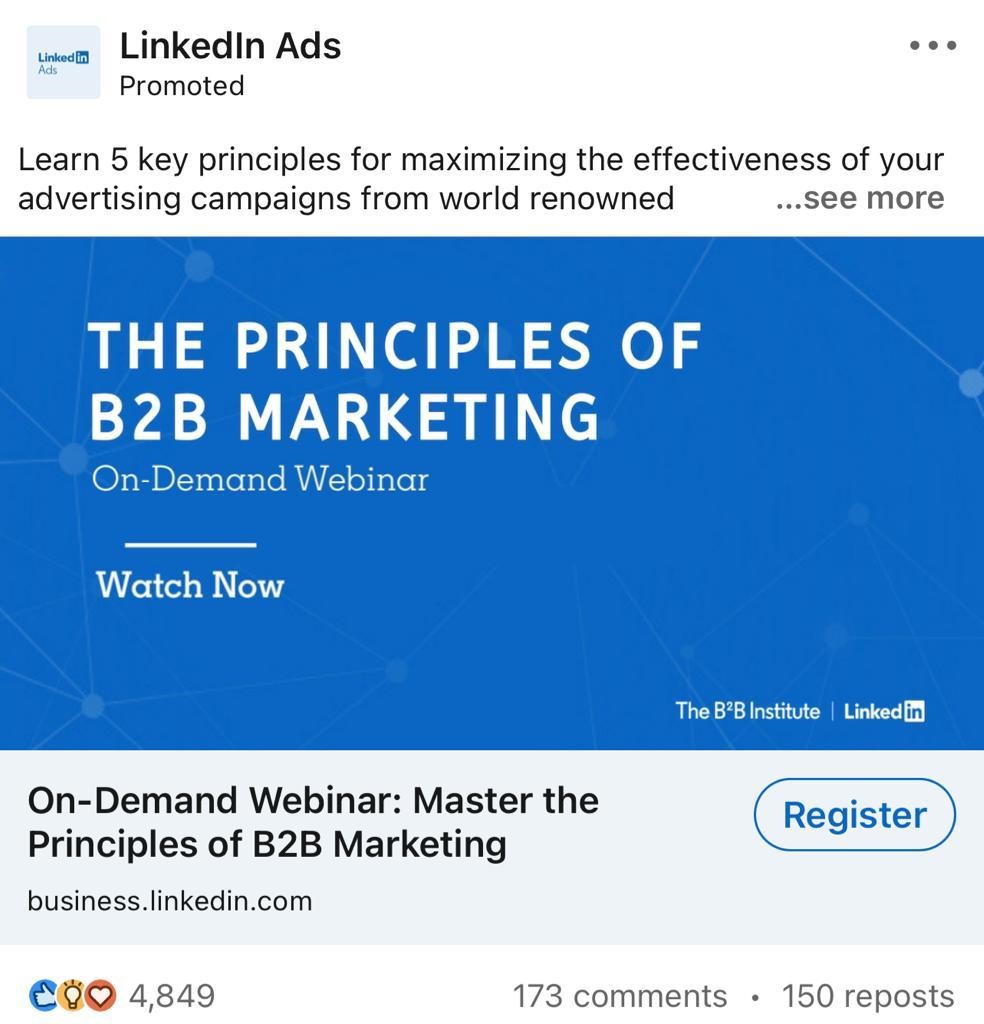
LinkedIn ads are like the notices you might see at the office or a job fair. When you’re on LinkedIn, sometimes you’ll see posts that look like regular updates but are actually ads. They’re made by companies who want to tell professionals about their services, job openings, or business events. These ads usually have a neat and tidy look, with a picture or a short video, some details about what they’re offering, and maybe a button you can click to learn more or sign up. It’s a straightforward way for businesses to talk to people who might be interested in what they have.
Cost of Social Media Ads
When we talk about the cost of social media ads, it’s like asking how much a shopping trip will cost. The answer? It depends. Just like shopping, where you might buy a few things or a whole cartful, in social media advertising, you can spend a little or a lot. Here’s what affects the cost:
- Platform Choice: Each social media platform has its own pricing. Advertising on Facebook might not cost the same as advertising on LinkedIn or Instagram. It’s like different stores having different prices for similar items.
- Ad Type: Remember the different types of ads we talked about? Each type has a different price tag. A simple image ad might cost less than a fancy video ad or an interactive ad.
- Target Audience: Who you want to see in your ad can change the price. If you’re targeting a very specific group of people, it might cost more. It’s like paying more for a specialty item that not everyone buys.
- Competition: If lots of businesses want to show ads to the same group of people, the price can go up. It’s like bidding in an auction; the more people want something, the higher the price can go.
- Ad Duration and Frequency: How long you run your ad and how often it shows up also affects the cost. Running an ad for a long time, or making sure it’s seen a lot, can add up.
- Budget Control: The good news is you can control how much you spend. Most social media platforms let you set a budget. You can say, “I only want to spend this much,” and the platform will stop showing your ad once you reach that limit.
- Paying for Results: Sometimes, you pay based on how well your ad does. This could be how many people click on it, how many people see it, or how many people do something because of it, like downloading an app.
The cost of social media ads can vary a lot, but the control is in your hands. You decide how much to spend based on what kind of ad you want to run, who you want to see it, and how long you want it to run. It’s a flexible system that lets businesses of all sizes take part, whether they have a small budget or a big one. This flexibility makes social media advertising a popular choice for reaching out to potential customers.
Advantages of Social Media Ads
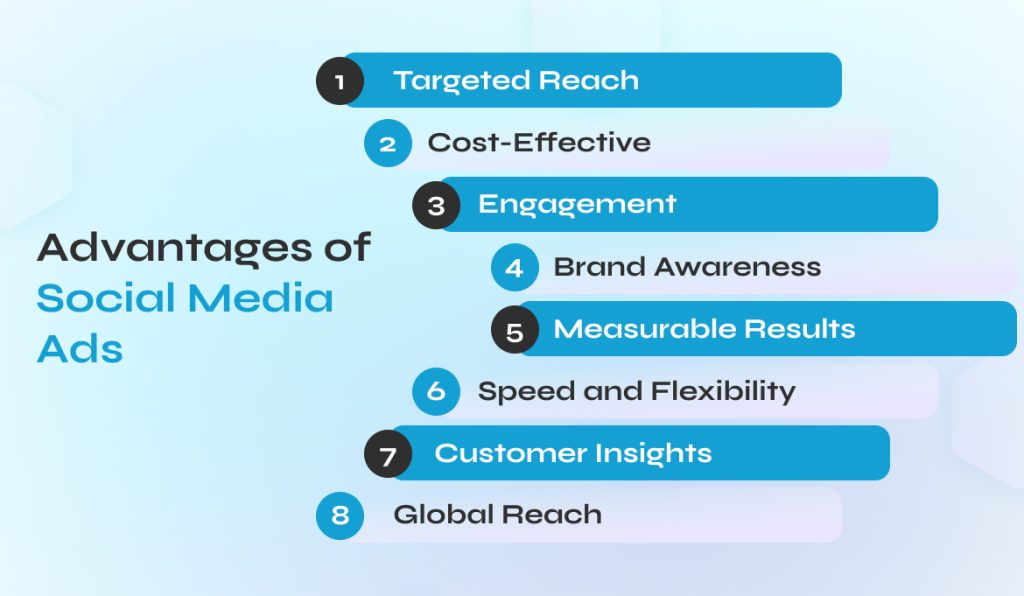
- Targeted Reach: One of the biggest advantages of social media ads is that they can be super specific about who sees them. It’s like sending a personalized invitation to a party. You can choose to show your ads to people based on their age, interests, location, and even their online behavior. This means your ad is more likely to be seen by people who might actually want to buy what you’re selling.
- Cost-Effective: Compared to traditional advertising like TV or billboards, social media ads can be much more budget-friendly. You can start with a small amount and increase it if you see good results. It’s like testing the waters before diving in, which is great for small businesses or anyone watching their spending.
- Engagement: Social media ads can get people talking. They can like, share, comment, or even tag their friends. This is like getting a thumbs-up from your customers, and it can help spread the word about your business faster and further.
- Brand Awareness: Even if people don’t immediately buy something, seeing your ad can help them remember your brand later on. It’s like planting a seed in their minds. Over time, this can build trust and recognition, which is super important for any business.
- Measurable Results: With social media ads, you can track exactly how your ad is doing. How many people saw it? How many clicked on it? Did they buy something? This information is like a report card for your ad, helping you understand what’s working and what’s not.
- Speed and Flexibility: You can create and launch a social media ad much faster than a traditional ad. Plus, if you see that something isn’t working, you can change it quickly. This is like being able to turn your car quickly to take a better road, instead of being stuck on a slow-moving highway.
- Customer Insights: Social media ads can give you a lot of information about your customers. What do they like? What do they talk about? This can help you make better products or services and create ads that are even more targeted in the future.
- Global Reach: With social media, you can reach people all over the world. This is great if you want to expand your business beyond your local area. It’s like opening a window to the whole world from your computer.
Social media ads offer a unique and powerful set of advantages. They’re like having a smart, flexible, and cost-effective assistant helping you reach exactly the right people, talk to them in a way they like, and understand them better. This can make a big difference in growing your business and making your brand stronger.
a loyal community around their brand. Social media also offers valuable insights into customer preferences and behaviors, helping small businesses tailor their offerings.
Crafting a Successful Social Media Ad Campaign
- Know Your Audience: This is like planning a party and knowing exactly who you’re inviting. Understanding who your audience is – their interests, age, location, and behaviors – is crucial. It helps you create ads that speak directly to them. For example, if you’re selling sports equipment, you’d focus on people interested in fitness and outdoor activities.
- Set Clear Goals: What do you want from your ad campaign? More website visits, more sales, or just more brand awareness? Setting clear goals is like having a roadmap. It guides you on what type of ads to create and how to measure their success.
- Choose the Right Platform: Not all social media platforms are the same. Instagram is great for visuals, while LinkedIn is ideal for professional services. Choosing the right platform is like picking the right place to set up your shop where your audience likes to hang out.
- Create Compelling Content: Your ad needs to grab attention and make people want to learn more. Use eye-catching images, engaging videos, and interesting text. It’s like having an eye-catching window display in a store.
- Use A/B Testing: This is like trying two different flavors of a cake to see which one people like more. Create two versions of your ad with slight differences (like different images or text) and see which one performs better. This helps you understand what works best with your audience.
- Budget Wisely: Decide how much you want to spend and stick to it. You can start small and increase your budget as you see results. It’s like investing a little in a new business and putting in more as it starts to grow.
- Monitor and Adjust: Keep an eye on how your ads are doing. Are people clicking on them? Are they leading to sales or sign-ups? This is like checking the temperature of your oven when you’re baking. If things aren’t going right, don’t be afraid to tweak your ad or try something new.
- Engage with Your Audience: If people comment on your ads, reply to them. This builds a relationship and makes them feel valued. It’s like having a friendly chat with customers in a store.
- Learn from Analytics: Use the data from your ad campaigns to learn. What time of day do people view your ads? What kind of content gets the most engagement? This information is like feedback that helps you improve your future campaigns.
- Stay Updated: Social media trends change quickly. What works today might not work tomorrow. Keep learning and stay updated with the latest trends and technologies.
Crafting a successful social media ad campaign involves knowing your audience well, setting clear goals, choosing the right platform, creating compelling content, wisely managing your budget, and constantly learning from your experiences. It’s a mix of good planning, creativity, and flexibility, all aimed at connecting with your audience in the most effective way possible.
FAQs
1. What are social media ads?
Social media ads are paid promotions run by businesses on platforms like Facebook, Instagram, and Twitter, designed to target specific groups of users based on their interests and behaviors.
2. Can you give me some examples of social media ads?
Sure! Examples include a Facebook carousel ad showing multiple images of a clothing line, an Instagram story ad for a new video game, or a promoted tweet about a tech company’s latest gadget.
3. What makes the best social media ads stand out?
The best social media ads are visually appealing, have a clear message, and include a strong call-to-action. They’re also highly targeted to appeal to the right audience.
4. How much do social media ads cost?
The cost can vary widely based on factors like the platform, ad format, targeting, and competition. You can start with a small budget and adjust as you see results.
5. What are paid ads on social media?
Paid ads on social media are promotional content that businesses pay to have shown to a wider audience than they would reach organically, with precise targeting options available.
6. What are the advantages of social media ads?
They offer targeted reach, measurable results, flexibility, customer insights, and a broad audience across demographics, making them a cost-effective choice for many businesses.
7. How do I start a social media ad campaign?
To start, you need to identify your target audience, set a budget, choose the right platform, create engaging ad content, and then track and adjust your campaign based on performance metrics.
8. What's the difference between organic posts and social media ads?
Organic posts are content that you create and share on your profile without paying for distribution, while social media ads are paid to reach a larger, more targeted audience.
9. How can I measure the success of my social media ads?
You can measure success through various metrics like click-through rates, conversion rates, engagement rates, and return on ad spend (ROAS).
10. Are social media ads only for selling products?
Not at all. Social media ads can be used for various goals, such as brand awareness, lead generation, event promotion, and more, not just for selling products.
Conclusion
That’s pretty much the story of social media ads. They’re not just random posts; they’re special messages from businesses hoping you’ll notice them. Whether it’s a cool photo or a fun video, these ads are looking to make a connection with you. And the best part? Any business, big or small, can put their ad out there. So next time an ad shows up in your feed, remember it could be something you’ll really like, all part of the big, friendly world of social media.

